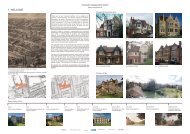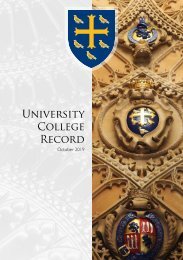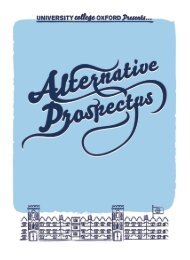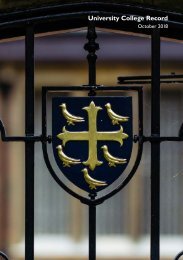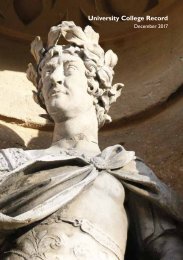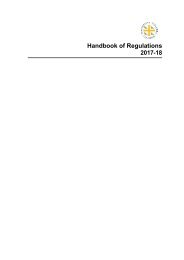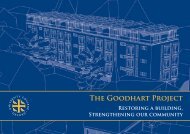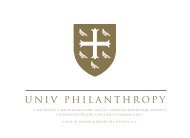University College Oxford Record 2020
Create successful ePaper yourself
Turn your PDF publications into a flip-book with our unique Google optimized e-Paper software.
Oxford undergraduates and postgraduates alike.
During this period, he spearheaded extensive
field-based programmes in Finnmark, northern
Norway, and the Cantabrian Mountains of
northern Spain. Harold saw about 40 students
from 10 countries through to successful higher
degrees. This spirit of generosity and selflessness
characterized his career throughout and was duly
recognized by his being awarded the Prestwich
Medal from the Geological Society of London
(in 1981) and the Twenhofel Medal from SEPM
(Society for Sedimentary Geology: an American
organization) in 1994, this latter award being the
highest form of recognition offered by this society.
He received a further medal from the Geological
Society, the Coke Medal, in 2001 as well as the
Silver Medal of the Society’s Petroleum Group in
the same year.
He was one of the founder members of the
British Sedimentological Research Group, which
has since taken on a life of its own, and there
now exists a Harold Reading Medal given by
this organization and awarded annually to the
postgraduate judged to have produced the best
publication arising from a soft-rock PhD project
during the previous year. Harold was equally
influential in the early days of the International
Association of Sedimentologists. He was President
of the organization in 1982-6 and, in 1999, was
its international lecturer, giving courses in Eastern
Europe, Jordan, India and Pakistan.
Harold had graduated from University
College in 1951, and subsequently undertook a
PhD at Durham University on the Carboniferous
Yoredale Group of the Stainmore Trough,
northern Pennines, which introduced him to
the world of clastic deposits and sedimentary
cycles. After leaving Durham he worked for Shell
in Venezuela for three years until appointed by
Lawrence Wager to a lectureship at Oxford
in 1957. Harold began teaching his course on
sedimentary environments soon afterwards but
it was not until some twenty years later that he
brought together a group of former students
and colleagues to write his textbook Sedimentary
Environments and Facies, the first edition of which
was published, to considerable acclaim, in 1978.
The fact that the book was reprinted six times is
testament enough to its popularity and editions
appeared in several other languages. A second
edition followed in 1986 and was again reprinted.
It remains a benchmark for the subject and is still
widely cited today. A third edition, with a change
in title, content and authorship, appeared in 1996.
Although Harold’s enjoyment of his later years
was curtailed by illness, he continued to take an
interest in the Department and attend alumni
events whenever possible. He is remembered
with great affection by his former students, many
of whom he taught in his role as tutorial fellow
in St Peter’s College. His wife, Bobbie, having
pre-deceased him, he is survived by his children
John, Peter, Caroline and Simon and his 11
grandchildren.
62 University College Record | October 2020



